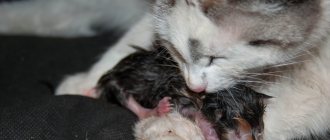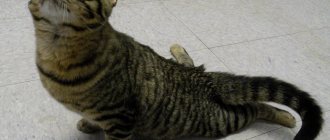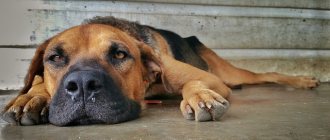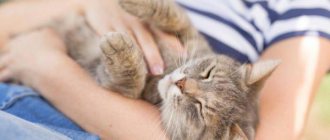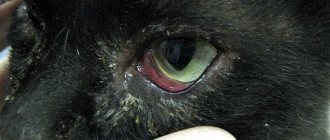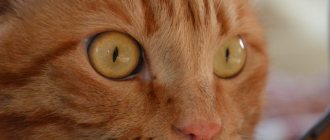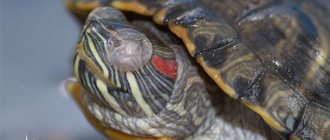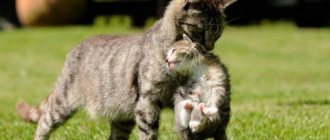12831Pavel
1
If you notice that your cat is squinting one eye, this may mean that the animal has a serious illness. Squinting of one eye is an alarming symptom indicating pain and discomfort in the pet's eye. Often, closing the eye is accompanied by profuse lacrimation or even suppuration. At this stage, it is important to immediately understand the causes of this condition in the cat and take all necessary therapeutic measures.
Why does a cat squint or close one eye, as if winking, what to do about it?
Most diseases and pathological conditions have external manifestations. However, different diseases can have the same symptoms. If the owner of a cat notices that she is squinting one eye, as if winking, this phenomenon cannot be ignored. It is necessary to find out why the pet's eye is closing and take measures to eliminate this problem, taking into account its cause.
Why do cats squint?
All cats squint their eyes from time to time. They screw them up because:
- They want to hide their fear from others. This feature was inherited by modern animals from wild ancestors, who, in order to survive in harsh conditions and not become victims of predatory animals, used any tricks, including squinting, which did not allow enemies to believe that potential prey was in a weak position.
- They try to protect their eyes from the claws of opponents.
- They demonstrate complacency to others. Sometimes animals send peculiar air kisses to their owners, squinting slightly. Cats give similar signs to other four-legged inhabitants of the house, informing them of their peaceful mood and complete trust (alertness is manifested by wide-open eyes with dilated pupils).
- Protects eyes from too bright light.
Why can a cat squint only one eye?
It is important to distinguish between cases when an animal squints with pleasure, covering both eyes, and when it has only one squinted. If it covers only the left or right eye, then something is preventing him from opening it completely. We need to find out the cause of this problem as quickly as possible. The slightest delay in some cases can lead to the loss of a diseased organ by the pet.
Foreign body in the eye
While walking while exploring secluded corners, your four-legged pet may get a speck or dirt in its eye. The foreign body will prevent him from blinking, so he will cover the affected organ. You can tell that your pet has got something in its eye by the following signs:
- increased rubbing with the paw;
- frequent blinking and squinting;
- increased lacrimation;
- redness.
Eye injury
If an animal closes one eye, it may have injured it while exploring tall thickets, fighting with relatives, or falling from a height. Excessive tearing and redness are the main symptoms of eye injuries. They can join:
- strabismus;
- edema;
- corneal clouding;
- bleeding;
- protrusion of the third eyelid.
If the injury is serious, the pet will meow pitifully and avoid touching the diseased organ. Also possible:
- discharge of mucus or pus;
- disorientation in space;
- change in iris color;
- change in the shape of the eyeball and its protrusion;
- deformation of the areas around the orbit;
- refusal of food and water;
- lethargy.
Inflammation of the conjunctiva
Does the cat look with only one eye? Perhaps her conjunctiva is inflamed. Conjunctivitis can be the result of a disease, such as calicivirus infection, viral peritonitis, or fungal diseases. Symptoms of the inflammatory process in the connective membrane depend on its type.
Bacterial conjunctivitis is accompanied by discharge of pus, swelling of the eyelids, inflammation of the mucous membrane, while viral conjunctivitis is accompanied by pain, itching, profuse lacrimation, and swelling of the eyelid. In the latter case, the pet may also develop nasal discharge and mouth ulcers, inflammation of the lymph nodes, and increased body temperature.
Inflammation of the third eyelid
A pet squints one eye if its third eyelid, or nictitating membrane, is inflamed due to injury, a foreign body entering the eye, allergies, infections, benign neoplasms, helminthic infestations, or dysfunction of internal organs. In this case, a film comes out from the inner corner and covers most of the eyeball.
What to do if your pet's one eye closes?
Information about what to do in this situation:
| Help your pet | Reason for squinting | Troubleshooting |
| Independent | Foreign body entry |
|
| With the participation of a veterinarian | Injury | Treatment depends on the type of injury and its cause. If it is serious (for example, a prolapsed eyeball or traumatic brain injury), the animal will require hospitalization and surgery. If a pet has a wounded eyelid, he is prescribed ophthalmic ointments and drops. Not all cases require sutures, as wounds in cats usually heal on their own. |
| Conjunctivitis | If the inflammation is of an allergic nature, the tailed patient is prescribed antihistamines. If it is caused by bacteria, you cannot do without antibacterial agents. To relieve the inflammatory process, ointment (tetracycline, erythromycin, Levomycetin, Sofradex) is applied twice a day to the inflamed eyelid and drops (Dexamethasone, Conjunctivin, Tsiprovet) are instilled. | |
| Inflammation of the third eyelid | Treatment depends on the provoking factor:
|
Source: https://MurKoshka.ru/zdorovye/bolezni/koshka-shchurit-odin-glaz.html
Description of possible causes
Rarely, there are cases when a cat squints one eye due to small particles (dust, specks) getting into it, which go away along with a tear after several blinks. The pet may squint for some time, but the next day (or after sleep) everything will pass without a trace. If this does not happen, then you need to look towards the following possible reasons:
- Injury. Can be obtained while climbing trees, quarreling with other animals, or after falling from a height. Damage is considered the most common cause of a cat squinting one eye. Very often the process is complicated by a bacterial infection, which manifests itself in purulent discharge and severe swelling of the eyelid. Unfortunately, it is very difficult to assess the extent of the damage yourself, since this requires a thorough examination of the entire eye using an ophthalmoscope. Even a small scratch on the inner eyelid or cornea can cause terrible discomfort to the pet, which may cause it to not open one eye at all. For minor injuries, Tobrex drops are usually prescribed (1 drop 6-8 times a day) and tetracycline ointment or Corneregel placed behind the eyelid (also 6-8 times a day).
- Foreign body. If a cat gets something in its eye, it begins to squint, as the cornea gets irritated every time it opens and closes. If a splinter is stuck in the third eyelid, the animal will feel discomfort and keep its eye closed until it is removed. It is more difficult when a foreign body gets stuck in the cornea. An ulcer forms in this area, which can lead to partial or complete loss of vision. In many cases, the process is complicated by a bacterial infection that enters through an open wound (ulcer). This can cause purulent discharge, terrible itching and swelling. You can get rid of the problem only by removing the foreign body and treating the consequences that could arise due to it (corneal ulcer, conjunctivitis, uveitis). In some cases, you can do this yourself (usually when a splinter is stuck in the inner eyelid). But, it is better to entrust this matter to a specialist, since many processes associated with the organs of vision may be irreversible.
- Double row of eyelashes. Occurs quite often at any age in all breeds. If the eyelash irritates the cornea, the cat will squint until it is removed. If you start this process, then there is a risk of developing corneal ulcers, bacterial and fungal conjunctivitis. Districhiasis can be eliminated surgically. The operation is absolutely safe and takes up to 15 minutes.
- Trichiasis. Unlike districhiasis, the problem may lie in one or more eyelashes, which grow in completely different places, not only from the edge of the eyelid, but also from the conjunctiva. Typically, such eyelashes are very hard and greatly irritate the cornea. Many owners do not dare to undergo surgical intervention, which will eliminate the problem once and for all, but choose the option of hair removal. Unfortunately, the risk that the eyelash will begin to grow again and injure the cornea is very high.
- Turn of the century. It is often diagnosed in the first year of an animal's life. At the initial stage, it may manifest itself in the form of increasing discharge. In the future, you may notice cloudiness. If the process is complicated by purulent conjunctivitis (which happens very often), then the cat squints its eye, and subsequently may not open it at all. Gradually, the cornea is covered with a film. If you start this process, then there is a high risk of developing symblepharon and keratitis. The first cannot be treated, the second is partially curable. The solution to the problem of entropion of the eyelids is only through surgical intervention. But, modern technologies make this operation absolutely safe and painless.
Separately, I would like to remind you about allergic conjunctivitis, which can also be the reason that a cat squints one or both eyes at once. It causes the eyes to become sour, red and very itchy. Scratching can cause a fungal or bacterial infection. Mostly decorative breeds suffer, which must immediately be switched to hypoallergenic food. Less often, the reason lies not in nutrition, but in house plants, to which it is necessary to limit access to all animals living in the house, since very often their juice is toxic to pets.
This is interesting: How to treat a kitten’s purulent eyes at home
What to do if your cat starts squinting one eye?
You need to understand that if a cat begins to squint one eye, then the chances of solving the problem at home are extremely low. And the longer the owner decides what to do, the more likely the pet is to lose his sight.
This is especially true in cases where, after a serious injury, an inflammatory process caused by a bacterial infection has begun. We also must not forget about congenital pathologies, allergies and infectious diseases.
Description of possible causes
If you look at the statistics, most often when owners complain that their cat is constantly squinting one eye, injuries to the organ of vision and infectious diseases (especially in kittens) are diagnosed.
Of the accompanying symptoms, great importance is given to discharge from the eyes, sudden cloudiness and redness of the whites. If any of the above symptoms appear, the following options must be excluded.
Foreign body
It can get under the third eyelid or directly into the cornea. Plant seeds, branches from trees or bushes, glass fragments (after an accident), and food debris can act as splinters. Each blink causes discomfort and pain, which causes the cat to often squint one eye.
The danger is that if the cornea is injured, there is a risk of secondary infection and the onset of an inflammatory process. It’s even worse if the pet tries to get the splinter out on its own using its paws and claws, which can significantly worsen the situation.
The first thing the owner should do is wash the eyes with lotion (Opticlia, Rosinka) and try to conduct an independent examination. There are times when the splinter digs in shallowly and can be easily removed with tweezers.
If the irritant cannot be detected or it has entered an inaccessible part of the eye, then it is best to seek help from an ophthalmologist. He will remove the foreign body and assess the extent of damage to the cornea and third eyelid. If necessary, prescribe anti-inflammatory drugs.
Injury
Can happen at any age. A fight, a game, climbing trees, an accident, falling from a height - all this often ends in eye damage.
If the third eyelid is injured, then for shallow scratches, antiseptic treatments for 3-7 days will be sufficient.
If the cornea is injured, an examination by an ophthalmologist is necessary to assess the extent of the damage. If a cat squints one eye for more than one day after any damage, then it is better to show it to a doctor, since some processes associated with vision are irreversible if medical assistance is not provided in time.
Corneal ulcer
The most common reason is that a cat constantly squints one eye. There is also almost always profuse lacrimation and redness of the third eyelid.
Injury to the cornea can occur during play, fighting, or getting a foreign body under the eyelid. Districhiasis and trichiasis, in which the cornea is often injured, can also be the cause.
The extent of the damage can be assessed only after a visual examination by an ophthalmologist and a special procedure for staining the cornea, which will show a clear location of the damage and the estimated depth.
In most cases, it is possible to manage with conservative treatment using antibacterial drugs (Torbex, Tsiprovet, Floxal) and Korneregel or Solcoseryl. The healing period may take 2 to 4 weeks, depending on the size of the ulcer.
If severe souring of the eye and purulent discharge occurs, it is recommended to see a doctor to rule out bacterial damage.
Trichiasis
Congenital pathology that manifests itself in the first year of life. Due to improper growth of even one eyelash, a cat may squint one eye, as there is discomfort during blinking.
In some cases, the eyelashes grow soft and do not interfere with the pet in any way, being only a cosmetic defect. But usually such eyelashes are hard and can seriously injure the cornea, so they must be removed without fail.
Depending on the location and number of eyelashes, anesthesia may be used under which hair removal is performed. In severe cases, several procedures may be needed to ensure that the hair follicle atrophies and the eyelash becomes thinner and softer.
Districhiasis
It is also considered a congenital pathology in which a double row of eyelashes is observed. Some of which necessarily injure the cornea and cause conjunctivitis and uveitis.
With this diagnosis, it is mandatory to remove all abnormally growing eyelashes. If this is not done, then at first the cat will squint its eye, then lacrimation, purulent discharge and clouding will appear. Ultimately, the eye becomes swollen with a cloudy film.
Cat squinting one eye photo
Click to see photo
There are times when it is not possible to see a doctor on the day of injury, and the animal needs first aid.
Therefore, for an antibacterial effect, you can use taufon or torbex.
But, remember that for a complete recovery it is necessary to assess the degree of damage (if it is an injury) or eliminate the irritating factor (if it is a foreign body or congenital pathologies).
Source: https://veterinariya.com/koshka-shhurit-odin-glaz.html
The cat squints in one eye: possible diseases and advice from a veterinarian
When both eyes of a cat are watery, everything is clear: conjunctivitis. If additional symptoms are detected, consult a doctor. If not, use ophthalmic ointments or drops.
But what to do when your pet only has one eye running or squinting? Should I not worry or should I go to the clinic? Are cat eye diseases dangerous for humans? This article answers the questions raised.
Causes
It should be noted right away: in most ophthalmological diseases of cats and humans, the pathogens are the same. Therefore, after touching your pet's eyes, you should wash your hands with special care.
Squinting indicates that the animal is experiencing pain or discomfort, which is caused by the following reasons:
- infectious diseases;
- injuries;
- inflammation of the third eyelid;
- glaucoma.
Clinical symptoms, diagnostic methods, treatment and prevention vary depending on the cause. Therefore, each disease is described in a separate section.
Contagious diseases
Damage to one eye is typical for the following infectious diseases:
- herpes;
- chlamydia;
- demodicosis;
Herpes
Blepharospasm
The viral disease is better known by the name rhinotracheitis. An acute course is typical for unvaccinated kittens from two to three months. Chronic disease occurs in adult animals during periods of weakened immunity. At the initial stage, blepharitis develops, which is characterized by inflammation of the eyelids. They stick together and blepharospasm develops.
Subsequently, the second organ of vision is also affected. A characteristic sign of rhinotracheitis is ulcers on the cornea of the eye. Self-medication is dangerous because it can cause loss of one or both eyes, bronchopneumonia, constipation, and damage to internal organs. Treatment is prescribed by a veterinarian. To prevent rhinotracheitis, kittens and sexual partners are vaccinated before mating.
Chlamydia
The bacterial infection primarily affects kittens from 1 to 3 months. At this time, death is possible. With chlamydia, one eye first becomes inflamed, then the second is affected.
Chlamydia affects one eye first
Treatment is prescribed by a veterinarian.
If ophthalmic ointments or drops are used, two eyes should be treated, even though one of them looks healthy.
Prevention consists of proper feeding, satisfactory living conditions and vaccination with a polyvalent drug against chlamydia and other dangerous diseases of cats.
Demodicosis
Demodectic glasses
The pathological process is caused by the activation of the subcutaneous mite due to weakening of the immune defense. With asymmetrical lesions, demodectic glasses are formed around one of the eyes. Soreness causes the pet to squint one eye.
Treatment consists of treating the affected surface with external insecticidal and acaricidal agents. If the pathological process goes far, inflammation occurs.
As the affected area heals, it scars and squinting becomes a lifelong cosmetic defect. Prevention consists of proper feeding, as well as applying insecto-acaricidal drops Spot on to the healthy, intact skin of the withers, which protect the pet from fleas, helminths, cutaneous and subcutaneous ticks.
Injuries
Unilateral damage most often occurs in a fight, and also occurs when a cat is stung by a bee. One side swells and the eye closes. A pet injures its eye while chasing prey, or when a splinter gets into the soft tissue or a small solid particle gets into it. Ophthalmic drops are used for treatment.
If the use of an external remedy does not lead to the desired results. Seek veterinary help.
Glaucoma
Glaucoma
Elderly pets suffer from numerous chronic diseases, against which eye pathologies develop. With glaucoma, intraocular pressure increases. The affected organ becomes sensitive to the slightest irritation. The cat develops photophobia: bright light causes the affected eye to squint.
Congenital glaucoma is observed in Persian, Siamese and British kittens. The development of the pathological process can be slowed down if the underlying disease is treated. Full recovery is impossible. Conservative treatment is aimed at relieving pain. If pathological signs increase, surgery is performed. Most often, the damaged organ is removed.
Glaucoma in a kitten
Prevention of congenital diseases involves excluding parents of sick kittens from breeding. Thoroughbred young animals should be purchased from trusted breeders who value their reputation.
Chronic diseases of older animals are prevented by compliance with housing and feeding standards, timely deworming and treatment against external parasites.
What does it mean if a cat squints one eye?
If a cat squints one eye, then you don’t even have to hope that the problem will solve itself. At a minimum, you will need to treat the affected organ of vision with an antiseptic solution.
But, in most cases, the reason lies in injuries, viral infections and other pathologies that affect the visual organs.
It is worth remembering that you should not delay a visit to an ophthalmologist, since aggravation of the inflammatory process can lead to complete loss of the animal’s vision or even removal of the eye.
Causes
Closing one eye indicates discomfort and pain. This happens for the following reasons:
- conjunctivitis;
- corneal trauma and erosion;
- inflammation of the third eyelid;
- age-related changes.
Conjunctivitis
Inflammation of the mucous membrane is not an independent disease, but a symptom of underlying diseases. The organ of vision turns red, first clear, and after 2-3 days mucous or purulent exudate flows out of it. If the cause of inflammation is injury, one eye is affected. With viral or bacterial infections, helminthic infestations, inflammation from one organ quickly spreads to another. The exception is chlamydia. For several days, one organ remains affected. This pathogen is not safe for humans.
Corneal injuries and erosions
Pain in the cornea causes the cat to squint. Most often, unilateral damage is typical for injuries received in a fight. Through a defect in the membrane, microflora penetrates into the organ and multiplies, melting the tissue. Corneal erosions are characteristic of rhinotracheitis, a viral disease of cats.
Inflammation of the third eyelid
The nictitating membrane protects the eye from debris. Normally it is invisible. However, due to injury or genetic predisposition, the third eyelid becomes inflamed and noticeable. The disease is characterized by profuse lacrimation. Over time, the exudate becomes mucous and then purulent. The discharge sticks the eyelids together and the eye stops opening. Blepharospasm develops.
Age-related changes
In old animals suffering from permanent illnesses, intraocular pressure increases. The affected organ hurts, which causes the pet to squint. If inflammation affects the choroid, one-sided blindness develops.
A cat squints one eye: common causes, diagnosis of eye diseases, treatment methods
If a cat squints one eye, this may be a sign of an ophthalmological pathology. The symptom indicates that the animal is experiencing pain or discomfort. Eye diseases are often accompanied by suppuration and increased lacrimation. Lack of timely diagnosis and therapy leads to dangerous complications.
It is important to establish a diagnosis and begin treatment as soon as possible.
Why doesn't a cat open one eye?
A constantly squinted or completely closed visual organ is a consequence of a pathological process in the body. All ophthalmological diseases in pets are divided into 3 groups:
- eye diseases;
- pathologies that arose against the background of other disorders;
- traumatic diseases.
If a cat’s eyes cannot open, the most common causes are the following pathologies:
- Keratitis, or inflammation of the cornea. Damage occurs due to injury, entry of a foreign body or chemical substance, or infection. Sometimes keratitis occurs against the background of helminthic infestation. It is accompanied by photophobia, lacrimation, discharge of pus, and redness of the corners of the eyes. Due to severe pain, the animal behaves restlessly and refuses to eat and drink.
- Conjunctivitis, or inflammation of the mucous membrane. The disease develops due to bacteria, viruses, and fungi entering the body. Inflammation of the conjunctiva may be one of the manifestations of allergies (to pollen or dust). Symptoms of the pathology include increased lacrimation, redness and swelling of the eyes, and discharge of pus.
- Glaucoma. Intracranial pressure increases due to injury or systemic disease. The outflow of intraocular fluid is disrupted. This leads to an enlargement of the eyeball, decreased visual acuity, and clouding of the pupil. At first, the cat or cat squints because it feels discomfort. In later stages, blindness is possible.
- Blepharitis, or inflammation of the edge of the eyelid. The disease occurs against the background of injury, infection, vitamin deficiency, parasite infection, burn (thermal or chemical). With blepharitis, the eyelids become red and thickened. The purulent scales that appear at the base of the eyelashes fall off and leave behind ulcers. The animal is in pain and constantly squints.
- Corneal erosion. The causes of its appearance are injuries, burns, viral, bacterial and fungal infections. The pet squints and scratches its eye with its paw, and behaves restlessly. Orientation in space is disrupted. If erosion is left untreated for a long time, a corneal ulcer may appear.
- Epiphora, or excessive tear production. Outwardly, the disease looks as if the animal is crying all the time. This leads to partial or complete blockage of the nasolacrimal duct. Epiphora can be congenital or acquired. An advanced form of pathology leads to the appearance of dermatitis.
A cat or cat may squint the visual organ due to mechanical injuries to the cornea. Most often this happens to pets that have free access to the street. Eye injuries received during fights or games with other animals often lead to inflammatory processes.
Diagnosis of the disease
If your pet constantly closes its eye, a veterinarian will find out the reasons. If alarming symptoms are detected, it is necessary to take the cat to the clinic.
Diagnostics includes procedures such as:
- visual acuity test;
- assessment of the general condition of the body;
- examination of the visual organs for damage;
- comparison of symmetrical features (size and shape of pupils, eyelids, eyeballs and slits);
- Ultrasound of the affected area;
- staining test;
- CT or MRI of the brain;
- X-ray of the skull.
Ophthalmological pathology may be a consequence of traumatic brain injury. Therefore, the examination must be comprehensive.
It is recommended to donate blood, urine and feces for analysis. Problems with the eyes can be caused by pathologies of internal organs or parasitic diseases.
Methods for treating eye diseases in cats
If your cat squints or squints, it needs to be seen by a veterinarian. The specialist will find out the cause of this phenomenon and prescribe treatment.
However, not everyone has the opportunity to immediately take their pet to the clinic. In this case, it is recommended to examine the animal at home and provide first aid.
To do this you need:
- check whether a foreign body has entered the eye;
- rinse the damaged visual organ with saline solution or warm boiled water;
- Carefully remove the pus, moving from the outer corner of the eye to the inner.
Without the doctor's permission, it is prohibited to use antiseptic solutions or antibiotics for rinsing and treatment. Medicines, eye drops and ointments are prescribed only by a veterinarian after diagnosis.
Severe cases require surgery and suturing. This treatment is carried out in a hospital setting.
Measures to prevent eye diseases
It is easier to prevent an ophthalmic disease in an animal than to treat it. Prevention includes:
- regular vaccination;
- preventing pet hypothermia;
- examination of the animal’s visual organs after street walks;
- washing the mucous membrane and eyelids with saline solution if wounds are found on them;
- timely contact a veterinarian.
A cat squinting its eye is not necessarily due to illness. Sometimes this is a variant of the norm, for example, when the animal is sleepy or calm. It is necessary to seek veterinary help if this symptom persists for a long time and is accompanied by lacrimation, pus discharge and deterioration in the pet’s physical condition.
Source: https://kotofan.ru/koshka-shhurit-odin-glaz/
Measures to prevent eye diseases
It is easier to prevent an ophthalmic disease in an animal than to treat it. Prevention includes:
- regular vaccination;
- preventing pet hypothermia;
- examination of the animal’s visual organs after street walks;
- washing the mucous membrane and eyelids with saline solution if wounds are found on them;
- timely contact a veterinarian.
A cat squinting its eye is not necessarily due to illness. Sometimes this is a variant of the norm, for example, when the animal is sleepy or calm. It is necessary to seek veterinary help if this symptom persists for a long time and is accompanied by lacrimation, pus discharge and deterioration in the pet’s physical condition.
All information posted on the site is provided in accordance with the User Agreement and is not a direct instruction to action. We strongly recommend that before using any product, you must obtain a face-to-face consultation at an accredited veterinary clinic.
The cat’s eyes are watery and he squints them: why, how to treat, the best remedies
Often, cat owners have the following problem: watery discharge begins to appear from the eyes or one eye of the animal, but do not panic prematurely. There are many reasons for watery eyes, and it is not necessarily a serious illness.
Before examining your pet, you should wash your hands and carefully examine the condition of the eye. It may be possible to make a diagnosis without resorting to the services of a veterinarian. So, one of the cat’s eyes is watering, what to do, how to cure it?
The animal's eyes are watery: reasons
Tearing can occur either from natural causes or as a result of illness.
In the first case, tears from the eyes may appear:
- After the furry animal woke up. This is a normal reaction of the body. The cat removes traces of tears itself by washing its face. For kittens, you can wash their eyesight with a swab moistened with boiled water.
- If the cat belongs to a certain breed. The Persian, the British, the Sphinx have tears and a peculiarity of the body. Persians are too fluffy, and doctors often diagnose the Sphynx breed with a disease called “entropion.” In this case, the animal can only be cured by resorting to surgery.
- If hair fibers get on the cornea. This symptom often occurs in long-haired small carnivores. The only thing that will help your cat is regular eye care.
In the second case, the cat may cry due to:
- Mechanical damage, injuries. A pet can damage the eyelid, eye, or cornea in a confrontation with another representative of its breed, during play or a walk. A sharp blade of grass or a twig that scratches the organ of vision can cause serious inflammation.
- Foreign objects. A small speck, a piece of tree bark, or a piece of plastic is enough to cause an inflammatory process to develop in a cat’s eye. Treatment in this case includes procedures for treating with solutions of antibacterial drugs.
- Burn. Curious animals often “poke their nose” into everything they find at home. Aggressive household chemicals, solvents, and wood varnish can become an object of curiosity, which will lead to a chemical burn. A pet can get a thermal burn if it becomes interested in cooking in the kitchen.
- Allergic reaction. Allergies are the scourge of the modern world; not only people, but also animals are susceptible to manifestations of allergies to various irritants.
- Incorrect eyelash growth. Sometimes a cat has a pathology - the eyelashes grow incorrectly, causing the pet a lot of suffering: the eyelid is inflamed, tears constantly ooze. In this case, the help of a veterinarian is required.
- Helminth infections. One of the signs of the disease is increased production of tears.
- Conjunctivitis. The infection is caused by chlamydia; only a veterinarian can cure the little predator.
- Colds. A cat often cries if it has a cold.
The cat has one eye watering and he squints it: is it normal or pathological?
The answer to the question depends on the breed of the animal and its general condition. A veterinarian will help determine the cause.
A cat's eye is watering: what to do?
Excessive production of tears from one eye requires immediate action on the part of the owner:
- Assessment of general condition. It is necessary to conduct a visual inspection, measure body temperature, and examine the cat for injuries.
- Treatment of the affected eye with furatsilin (solution), decoctions of medicinal herbs.
- A trip to the veterinary clinic.
During treatment, a number of rules should be followed:
- Rinse both healthy and affected organs of vision.
- Remove the allergen from the home if an allergic reaction is diagnosed.
- When treating an infection, lubricate the eyes with ointments 2 times a day.
- If surgery is required, do not remove the special collar from the cat until complete healing.
Folk remedies
You can replace medications with infusions and decoctions prepared from medicinal herbs:
- Chamomile flower decoction.
- Decoction of calendula flowers.
- Infusion with St. John's wort, sage.
- A weak solution of potassium permanganate.
- Green tea infusion.
Anti-tear medications
At home, you can help by using a number of means:
- Furacilin solution for rinsing.
- Drops based on chloramphenicol.
- Antibiotic ointments.
- Ointments with antihistamine effect.
Prevention
To ensure that the furry animal’s eyes are in perfect order, a number of preventive procedures should be carried out in a timely manner:
- regularly carry out preventive measures against worms,
- examined at a veterinary clinic,
- do not forget about hygiene procedures (combing fur, washing eyes, cleaning ears).
If there is increased tearing, you need to visit a veterinarian to find out the cause of the ailment.
Source: https://KotikDoma.com/simptomy-bolezney/obschie-nedomoganiya-koshek/u-koski-slezitsa-odin-glaz.html
Why do my cat's eyes water and fester?
If a pet discharges purulent exudate from one or both eyes, they become watery, the animal constantly squints and becomes lethargic, this may be due to the development of conjunctivitis, a foreign body entering the eye, inflammation of the eyelid margins, or an infection of viral, bacterial or fungal origin. The listed diseases manifest themselves in different ways, and you can identify the cause of sour eyes by knowing the symptoms of each of them.
Conjunctivitis of various etiologies
In veterinary medicine, this term refers to inflammation of the conjunctiva, the thinnest mucous membrane that covers the eyeball from the outside and the eyelids from the inside. This disease, depending on the source of the lesion, can be bacterial, viral, fungal, or allergic, each of which manifests itself in its own way. The table provides a description of the types of conjunctivitis.
How to help your pet at home?
In order to provide qualified assistance to your cat, it is necessary, first of all, to know the root cause and accurate diagnosis of the disease. After all, the phenomenon in itself, when a cat squints its eye, is not considered an independent disease; it is only a consequence of hidden pathologies in the animal.
What to do if you can’t immediately visit the veterinarian’s office
- Examine your cat's eye for yourself as it squints. Make sure there are no foreign bodies in it.
- Gently but thoroughly rinse your pet's eyes with a slightly warm saline solution or regular boiled water. Use a sterile gauze swab.
- You need to collect discharge and pus very carefully, moving from the outer corner of the eye to the inner. Do not press on the eyeball under any circumstances, because the animal experiences severe pain and squints its eye to reduce it.
- It is strictly prohibited to use cotton pads during the rinsing procedure to avoid sticking of cotton fibers to the cornea of the diseased eye.
- It is strictly forbidden to use solutions of antiseptics and antibiotics for washing. This can aggravate the pet's condition and cause a burn to the cornea of the eye.
If your pet begins to systematically squint its eyes, you should immediately take the animal to the veterinarian’s office without waiting for complications!


